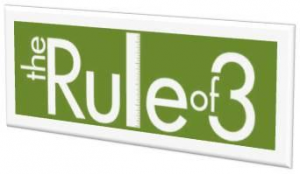
The Rule of  Three states that more than ‘three’ of– whatever– is confusing, overwhelming… it’s a principle that suggests– things that come in ‘three’ is inherently easier to understand, more satisfying, more effective… than other numbers of things. Rule of Three is applicable to many situations and often times the reality is– less is more, and slight more is better (i.e., three is just about right)… According Jagdish Sheth, Rajendra Sisodia; Rule of Three is more than an interesting theoretical construct; it’s a powerful empirical reality that must be factored into corporate strategy:
Three states that more than ‘three’ of– whatever– is confusing, overwhelming… it’s a principle that suggests– things that come in ‘three’ is inherently easier to understand, more satisfying, more effective… than other numbers of things. Rule of Three is applicable to many situations and often times the reality is– less is more, and slight more is better (i.e., three is just about right)… According Jagdish Sheth, Rajendra Sisodia; Rule of Three is more than an interesting theoretical construct; it’s a powerful empirical reality that must be factored into corporate strategy:
The ability of executives to develop alternative strategies that can result in success; however, developing more than ‘three’ alternatives becomes problematic… According to Carol Roth; there is Rule of Three in business, e.g.; everything takes 3 times longer; is 3 times as costly; is 3 times more difficult than you expect it to be… According to Michael Raynor, Mumtaz Ahmed; three incredible rules of business are; Rule 1: Better before cheaper (compete on differentiators other than price); Rule 2:Revenue before cost (prioritize increasing revenue over reducing costs); Rule 3:Follow rules 1 and 2– there are no other rules… Companies don’t become truly great by reducing– costs, assets… they earn their way to greatness through profitable growth… The Rule of Three dictates that a person should limit their attention to three tasks, goals… When applied to strategy the ‘rule’ prescribes– reducing the many possibilities down to three alternative courses of action; anything more becomes– overextended, confused… According to General John Admire; if the decision-making loop is more streamlined than the competitor’s then you set– the pace, course, rules… for the competition; streamlined means not greater than three…
Rule of Three is based on the concept that people tend to remember only three things… In oratory it comes up all the time, for example; good speeches are peppered with lists of three items: Friends, Romans, Countrymen; Blood, Sweat, Tears… They are also used in public safety: Stop, Look, Listen… Also, in the film industry: Good, Bad, Ugly; Sex, Lies, Videotape… Putting it simply; if you want a message to be remembered put it into a list of three: Think about… Here are several more examples: Life, Liberty, Pursuit of Happiness; Government of the People, By the People, For the People; Lies, Damned Lies, Statistics; Not the End, Not Even the Beginning of the End, Perhaps the End of the Beginning; Veni, Vidi, Vici- (I came, I saw, I conquered); Duty, Honor, Country… and the list goes on… According to Michael Raynor and Muntaz Ahmed; it’s always difficult to take something as complicated as business success and truly distill it down to 3-simple rules, 3 essential elements, which can make the business truly great, but here are 3 to think about:
- Rule 1: Better Before Cheaper: When it comes to how you differentiate yourself from the competition, seek out a position based on non-price value, i.e., performance, which is broadly understood. Do not compete on price. Price-based competition can work, but only rarely does it drive exceptional performance…
- Rule 2: Revenue Before Cost: Driving superior profitability means having combination of higher revenue and lower costs, than the competition. The advantages of higher revenue tend to be more valuable and durable than the advantages of lower cost. Use your differentiated position to charge higher prices or appeal to more customers. Do not try to ‘cut’ your way to greatness. Just like price-based competition, cost advantage can be effective, but only infrequently…
- Rule 3: There Are No Other Rules: Whatever competitive, environmental… challenges you might face– don’t give up on the first two rules. But, everything else is up for grabs — everything. Change whatever you must– market, people, technology… anything. But no matter what, stick with– better before cheaper, revenue before cost.
In the article Rule of 3 For Business Survival by Joseph Lizio writes: Most people have heard of the ‘Rule of 3′ in survival: As people (humans) we cannot survive after– 3 hours of exposure (extreme heat or cold), 3 days without water, 3 weeks without food… A similar rule of 3 can apply to business survival: Business cannot survive– 3 hours without some marketing: Every 3 hours you must be doing something to market the business. Customers have very short attention spans– usually not more than 3 hours to remember, recall… a specific marketing message. Just try to recall the last product brand commercial you– saw, read, act-on… Hence, the goal of marketing is– keep the right message in front of the right people all the time… That means every 3 days the business should be doing something to engage, retain… key customers. The bottom line– no matter what the market, economy… is doing, if you focus on, set aside time… for customers– the business will not only survive, but grow… Just simply act on the ‘Rule of 3′ and always look to the future…
In the article How to Use the Rule of Three to Create Engaging Content by Brian Clark writes: What’s so magical about the number three? It’s no accident that the number three is pervasive throughout some of our greatest– stories, fairy tales, myths… It’s also no coincidence that some of the most famous quotes from throughout history are structured in three parts, nor is it surprising that the Rule of Three also works wonders in the world of comedy… It all comes down to the way we humans process information. By necessity we’ve become proficient at ‘pattern recognition’ and three is smallest number of elements required to create a pattern. This combination of pattern and brevity results in memorable content, and that’s why the Rule of Three will make you more engaging, for example:
- Storytelling: Have you ever wondered– What the three little pigs, the three blind mice, Goldilocks and the three bears, the three Musketeers, the three wise men, the Three Stooges… have in common? Why the three-act structure is the dominant approach to screenwriting in Hollywood? Why three bullet points are more effective than two or four? The Rule of Three works in stories due to the presence of the concise, memorable patterns… Think in terms of three when crafting content and you’ll likely end up with a more engaging outcome. If at first you don’t succeed, remember– the third time’s the charm…
- Sticky Ideas: You see the Rule of Three used all the time across diverse areas of life. Why? Because information presented in groups of three sticks in our mind better than other clusters of items. For example: Life, Liberty, Pursuit of Happiness: Government of the People, By the People, For the People: Friends, Romans, Countrymen: Blood, Sweat, Tears: Location, Location, Location: Father, Son, Holy Spirit: Faith, Hope, Charity: Mind, Body, Spirit: Stop, Look, Listen: Sex, Lies, Videotape: I Came, I Saw, I Conquered… If you want something stuck in someone’s mind, put it in a sequence of three…
- Humor: One of the best examples of the power of the Rule of Three is in the world of comedy. Again, three is the smallest number of elements that can form a pattern, and comedians exploit the way our minds perceive expected patterns to throw you off track (makes you laugh) with the third element… The Rule of Three fits the classic joke structure of– set-up, anticipation, punch-line… The three-part grouping also allows for tension to build, and then be released– thanks to the surprise, absurdity contained in the third element… Professional comedians use it all the time, and that’s simply because it works…
- Other Uses for the Rule of Three: I truly do believe that a set of three bullet-points is the most effective use of the format. You might also find that a list posted with three items will draw people in– because it reduces things down to the essence with no fluff. There’s a reason people like to be presented with three choices rather than two or five– because when it comes to pleasing human brain, it seems like ‘three’ is simply a magic number…
In the article 3-Golden Rules Of Business by Eric write: There is nothing more important to the life blood of business then these three actions: Get Customers, Keep Customers, Make Money… This is what we call ‘Prime Directive’; it’s the prime #1 mandate, top-of-the-mind focus, and the guidance that drives every decision for every manager, leader, employee, stakeholder, director… Anyone who has skin-in-the-game in the business… The Prime Directives are– not because we say they are but because they are– most elemental building blocks of business success… beyond which ‘everything else’ is merely interesting details… Notice that the Prime Directives are comprised of 3-powerful verbs– action words in the broadest sense of the meaning. Say this words often: Get, Keep, Make; Get, Keep, Make; Get, Keep, Make… Repeat them often; but most important– ‘do what the words say’ for building-sustaining a successful business…
The Rule of Three is a fun, easy-to-use… universal truth. It gives business more impact, makes marketing more effective, advertising more persuasive… We’re all aware– at least intuitively– of the power of three: A string of three– words, things, ideas… pop-up all the time in literature, expressions, storytelling… According to Wikipedia; the Rule of Three is a principle that suggests that things that come in ‘three’ are inherently– funnier, more satisfying, more effective… than other numbers of things. According to Kurt A. Carlson, Suzanne B. Shu; to produce the most positive impression of a product, service… use the ‘charm of three’ to minimize skepticism, maximize positive impression… when selling list only three positive claims… According to Carmine Gallo; the phrase– life, liberty, pursuit of happiness– is probably one the most well-crafted, influential phrases in the history of the English language… it was written by Thomas Jefferson who was a skilled writer– this famous phrase reflects a rhetorical technique that can be traced to ancient Greece– a figure of speech using three words to express one idea… The Rule of 3 is everywhere, for example; Steve Jobs applied the Rule of Three in nearly every presentation, product launch… Since it worked for Jefferson, it worked for Jobs… it can work for you– try it. According to Martin Gladwin; the human view of the world is created by interpreting what happens to us through three elements: How we think, move, feel… Personal success is a result of properly using these three closely interrelated elements. What you think is a result of how you feel, and where you are. How you feel is a result of what you think, and what you’re doing. And what you do is a result of how you feel, and what you think. If any of these three elements isn’t right then look to change the other two. Once you get all three working together, your options are enormous… Just think about that for a while… It’s really that simple…
By Source






























